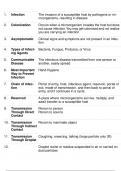NR224- Exam 1
Study online at https://quizlet.com/_376eqv
1. Infection The invasion of a susceptible host by pathogens or mi-
croorganisms, resulting in disease
2. Colonization Occurs when a microorganism invades the host but does
not cause infection. You may get colonized and not realize
you are carrying an infection
3. Asymptomatic Clinical signs and symptoms are not present in an infec-
tion
4. Types of Infect- Bacteria, Fungus, Protozoa, or Virus
ing Agents
5. Communicable The infectious disease transmitted from one person to
Disease another, easily spread
6. Most Important Hand Hygiene
Way to Prevent
Infection
7. Chain of Infec- Portal of entry, host, infectious agent, reservoir, portal of
tion exit, mode of transmission, and then back to portal of
entry, and it continues in a cycle.
8. Reservoir A place where microorganisms survive, multiply, and
await transfer to a susceptible host
9. Transmission Person to person
Through Direct Person to source
Contact
10. Transmission Person to inanimate object
Through Indirect
Contact
11. Transmission Coughing, sneezing, talking (large particle only 3ft)
Through Droplet
12. Droplet nuclei or residue suspended in air or carried on
dust particles
, NR224- Exam 1
Study online at https://quizlet.com/_376eqv
Transmission
Through
Airborne
13. Transmission Food, water, drugs and solutions, blood, fomites (organic
Through something)
Vehicles
14. Transmission External transfer
Through Vector Internal transmission (parasitic)
Mosquito, louse, flea, tick
15. Immunocompro- Having an impaired immune system
mised
16. Virulence The ability to produce disease, how strong the disease is,
the intensity of the disease
17. Aerobic Bacteria Requires oxygen for survival and for multiplication suffi-
cient to cause disease
18. Anaerobic Bacte- Thrive where little or no oxygen is available
ria
19. Bacteriostasis Prevention of growth and reproduction of bacteria
20. Bactericidal Destructive to bacteria
21. Four Stages of 1. Incubation Period
Infection 2. Prodromal Stage
3. Illness Stage
4. Convalescence
22. Incubation Peri- The first stage of the infectious process. It is the time in-
od terval between entrance of the pathogen and appearance
of the first symptoms.
23. Prodromal Stage The second stage of the infectious process. It is the
interval between onset of nonspecific symptoms to more
, NR224- Exam 1
Study online at https://quizlet.com/_376eqv
specific symptoms. You don't feel well, but you aren't sure
why
24. Illness Stage The third stage of the infectious process. The interval
when a patient manifests signs and symptoms specific to
the type of infection. You have the illness and can confirm
what it is
25. Convalescence The interval when acute symptoms of infection disappear,
you start feeling better.
26. Localized Infec- Patient experiences symptoms in one specific area, the
tion infection is in one spot. There is no fever (fever means it's
systemic)
27. Systemic Infec- An infection that affects the entire body, it can be fatal if
tion not detected or untreated.
28. Normal Flora Microorganisms that reside normally in our body. They
help resist infection by releasing antibacterial substances
and inhibiting multiplication of pathogenic microorgan-
isms
29. Body De- Normal flora, intact skin, mucus membranes, cilli in respi-
fense Mecha- ratory system, fever, inflammation, vascular and cellular
nisms Against response, and tissue repair
Infection
30. Inflammation Vascular and cellular response leads to blood gather-
ing in the area, exudates appear (serous=clear, san-
guineous=red, purulent=white/yellow), tissue repair
31. Healthcare-Asso- Also called nosocomial infection, results from delivery of
ciated Infection health services in a health care facility. Can occur as
(HAI) the result of invasive procedures, antibiotic administra-
tion, the presence of multidrug-resistant organisms, and
breaks in infection prevention and control activities
32. Patients at Risk If the patient has multiple illnesses, older adults, poorly
for HAI nourished, lowered resistance to infection critical/chronic




